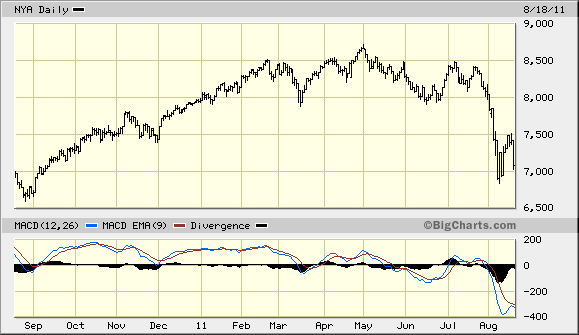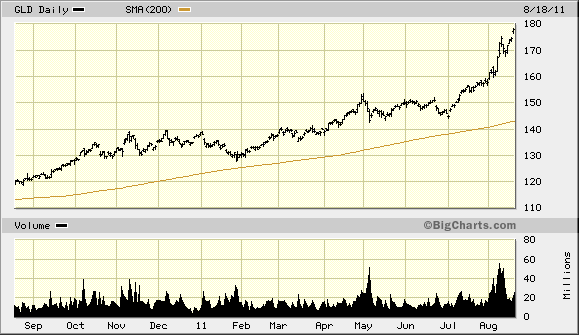Economists Refuse to Recognize the New Great Depression
Stock-Markets / Financial Markets 2011 Aug 19, 2011 - 01:09 AM GMTBy: Clif_Droke
 The recent financial slump has caused economists to take stock of the possibility of a "double dip" recession. Most of them, however, won't admit that the economic contraction which began in late 2007 is still underway and, worse still, has a few more years to run according to the Kress cycles. In this commentary we'll address this issue and have a look at where the cycles are leading the financial market and the economy.
The recent financial slump has caused economists to take stock of the possibility of a "double dip" recession. Most of them, however, won't admit that the economic contraction which began in late 2007 is still underway and, worse still, has a few more years to run according to the Kress cycles. In this commentary we'll address this issue and have a look at where the cycles are leading the financial market and the economy.
One sign that the long term cycles are leaning heavily against the financial market and the economy can be seen in the ease with which negative economic headlines can catalyze a stock market sell-off. This action is typical of a bear market. The recent sell-off is also a sign that the positive effects of the peaking 6-year cycle is being somewhat muted by the longer term cycles which are in steep decline.
The 120-year cycle, along with its various components cycles, will bottom in late 2014. The final "hard down" phase of this Mega Cycle began in 2008 with the peak of the 12-year cycle. Currently only the 6-year cycle - one of the smallest cycles in the 120-year series - is ascending, but once it has peaked in a few weeks the market will enter a cyclical configuration that hasn't been seen since 1892. That year was the last time the U.S. entered a cyclical "vortex" as the 120-year cycle caused a collapse in asset prices and led to a major economic depression.
Monetary regulators have had their work cut out for them in the last couple of years but have been fortunate to have caught a major break thanks to the yearly cycles. One thing that has been propitious for the Fed in its attempt to stimulate the financial economy is the 6-year cycle. As previously discussed, this important cycle bottomed in late 2008 and helped make possible the success of the Fed's first quantitative easing initiative.
The year 2009 witnessed a powerful recovery rally in the major indices, which was a product of the first quantitative easing program (QE1), the 6-year up cycle and the 10-year cycle peak in late 2009. The peaking of the 10-year cycle at the end of QE1 contributed to the "flash crash" of 2010. With the commencement of the Fed's second quantitative easing program (QE2) in November 2010, the final peaking phase of the 6-year cycle helped the stock market experience eight more months of recovery before the latest mini-crash descended on Wall Street.
It's amazing when you consider that the recent market collapse in less than a month completely destroyed eight months of recovery work courtesy of the Fed. As of this writing, the NYSE Composite Index (NYA) is below where it started in November 2010 when QE2 began.

The final yearly cycle peak of long-term significance is scheduled for around Oct. 1 and should provide the impetus for at least one more rally this year. Once the 6-year cycle peaks, the Fed will find it difficult to produce any meaningful boosts to asset prices. QE2 has already proven to be largely ineffective - if not an outright failure - and any further attempt at asset price manipulation will run counter to the longer term cycles. Deflation will be the operative word as we approach the Grand Super Cycle bottom in late 2014.
One of the hallmarks of this long-term deflationary phase which began in 2008 is rapid change. The complete retracement of the November 2010-June 2011 equity market rally in about a month's time is an example in microcosm of the rapid change that deflation can effect. An event bigger problem that will soon confront us is how quickly small, ephemeral gains made in the employment rate and other economic indicators can quickly reverse, essentially undoing the 2009-11 recovery.
Currently the economic malaise the U.S. is suffering is being misdiagnosed by the government's economists. The slack demand in the economy and persistently high unemployment levels have been called a "soft patch" by some and a "recession" by others. Experience teaches that a true recession is a temporary decline followed by a reasonably brisk return to normal conditions. What we're seeing instead is 4-year period of economic weakness with no return to normal. To that end the economic spin doctors insist on calling this the "new normal" when in actuality these conditions are abnormal.
The current economic malaise can best be described as a depression. A depression is essentially a period of several years in which economic performance is below normal and unemployment remains stubbornly above the average. But the word "depression" is a politically unpalatable word. It's much more soothing to the ear to us terms like "soft patch" or "Great Recession." No one has the guts to use the cold, harsh "D word" but it would be more helpful for most Americans if they informed that a New Great Depression is underway. This condition is being brought to us courtesy of the 120-year cycle decline which still has a few more years to run, and sooner or later everyone will have to face facts and address the problems associated with deflation.
When deflation sets in to an even fuller extent after the 6-year cycle peaks, economists will be awe-struck at the rapidity with which economic downside momentum increases. Investors should accordingly prepare for deflation in the years 2012-2014.
Price of Gold
One concern for the near term gold outlook is of a technical nature. The gold price is currently overextended from its 200-day moving average by nearly 22%. This is the first time in over two years that this has occurred and it shows how exceedingly "overbought" gold is right now. Below you can see the SPDR Gold Trust ETF (GLD), a proxy for the gold price, in relation to its 200-day MA.

The 200-day moving average is widely followed by investors, both institutional and individuals alike and is therefore psychologically important. Whenever the gold price has become this distended from its 200-day MA, a correction of varying magnitude can always be expected. The gold price could still make a final high this week before correcting, but the indicators suggest gold is very close to entering a correction period, be it a lateral consolidation or a corrective decline. Accordingly, traders and investors should book some profit here if you haven't already and tighten stop losses on remaining long positions in gold relative to your investment time frame.
Moving Averages
With the return of volatility anticipated in 2010, it will be important to have a technically sound trading discipline. Classical trend line methods can be useful but they aren't particularly suited for a fast-moving, dynamic market environment. This is especially true where turning points occur rapidly in a market that is subject to cyclical crosscurrents as 2010 is likely to be. That's where moving averages come in handy.
With a good moving average system a trader can be reasonably assured of catching most of the important moves in an actively traded stock or ETF while eliminating many of the whipsaws that attend trading choppy markets. In the book "Stock Trading with Moving Averages" we discuss some market-tested methods that have proven successful across most major stock sectors and industry groups, and is especially geared toward the gold and silver mining stocks and ETFs. Here's what one reader had to say about the book: "...you were the one who supercharged my charting with your moving average book 'Stock Trading with Moving Averages' and your constant analysis of the double and triple moving average series."
Moving averages offer another advantage over trend lines in that they can be tailored to closely fit the dominant short-term and interim market cycles. They're also more compatible with a trading range-type market...if you use the right moving average system. These and other strategies and tactics are discussed in "Stock Trading with Moving Averages." Order your copy today and receive as an added bonus my latest booklet on the best moving averages to use for long-term trading and investing. Click here for more info: http://www.clifdroke.com/books/book14.mgi
By Clif Droke
www.clifdroke.com
Clif Droke is the editor of the daily Gold & Silver Stock Report. Published daily since 2002, the report provides forecasts and analysis of the leading gold, silver, uranium and energy stocks from a short-term technical standpoint. He is also the author of numerous books, including 'How to Read Chart Patterns for Greater Profits.' For more information visit www.clifdroke.com
© 2005-2022 http://www.MarketOracle.co.uk - The Market Oracle is a FREE Daily Financial Markets Analysis & Forecasting online publication.



